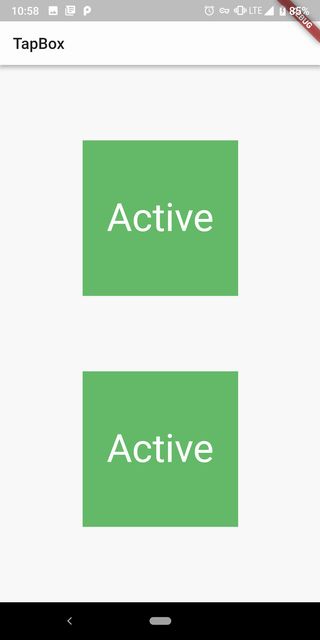Flutter 有两种状态控件:StatelessWidget、StatefulWidget,对于有可变状态控件的管理,官方文档是写了有3种模式:控件自己管理状态、交给父控件管理状态以及混合管理。我个人初学对于自己管理比较好理解,对于父控件管理理解起来有点困难,所以只能多看多学。这里写一下两种状态管理的方式和代码,加深自己的印象,尤其是父控件管理方式。
项目说明:两种方式实现一个容器盒子,点击的时候切换颜色和显示内容。我将把这两个盒子做到一个页面,虽然最终效果是一样的,但是实现方式不同。
一、控件自身管理自己的状态
/*
TapBoxA 是自身widget管理自己状态
*/
class TapBoxA extends StatefulWidget {
@override
_TapBoxAState createState() {
return new _TapBoxAState();
}
}
class _TapBoxAState extends State {
bool _aActive = false;
void _aActiveChanged() {
setState(() {
if (_aActive) {
_aActive = false;
} else {
_aActive = true;
}
});
}
@override
Widget build(BuildContext context) {
return new GestureDetector(
onTap: _aActiveChanged,
child: new Center(
child: new Container(
alignment: Alignment.center,
width: 200.0,
height: 200.0,
child: new Text(
_aActive ? 'Active' : 'Inactive',
style: new TextStyle(fontSize: 50.0, color: Colors.white),
),
decoration: new BoxDecoration(
color: _aActive ? Colors.green[400] : Colors.grey),
),
),
);
}
}
二、由父控件管理子控件的状态
子控件自身是无状态的控件,但是父控件会在子控件发生变化以后得知这一更新,并进行状态的更新以及控件的重绘。
/*
TapBoxB 是父widget管理子widget状态;
TapBoxB 继承自无状态控件,不管理任何状态
*/
class TapBoxB extends StatelessWidget {
TapBoxB({Key key, this.bActive: false, this.onChanged}) : super(key: key);
final bActive;
final ValueChanged onChanged;
void _bActiveChanged() {
onChanged(!bActive);
}
@override
Widget build(BuildContext context) {
return new GestureDetector(
onTap: _bActiveChanged,
child: new Center(
child: new Container(
alignment: Alignment.center,
width: 200.0,
height: 200.0,
child: new Text(
bActive ? 'Active' : 'Inactive',
style: new TextStyle(fontSize: 50.0, color: Colors.white),
),
decoration: new BoxDecoration(
color: bActive ? Colors.green[400] : Colors.grey),
),
),
);
}
}
/*
ParentWidget类是TapBoxB的父类
他会得知盒子是否被点击从而管理盒子的状态,通过setState更新展示内容
*/
class ParentWidgetB extends StatefulWidget {
@override
_ParentWidgetBState createState() {
return new _ParentWidgetBState();
}
}
class _ParentWidgetBState extends State {
bool _bActive = false;
void _handleTapBoxBChanged(bool value) {
setState(() {
_bActive = value;
});
}
@override
Widget build(BuildContext context) {
return new TapBoxB(
bActive: _bActive,
onChanged: _handleTapBoxBChanged,
);
}
}
最后是代码整合,把上面两个不同方式实现盒子点击状态更改的代码在一个APP里展示出来
import 'package:flutter/material.dart';
void main() => runApp(new MyApp());
class MyApp extends StatelessWidget {
@override
Widget build(BuildContext context) {
return new MaterialApp(
title: 'TapBox',
theme: new ThemeData(primaryColor: Colors.white),
home: new Scaffold(
appBar: new AppBar(
title: new Text('TapBox'),
),
body: new Column(
mainAxisAlignment: MainAxisAlignment.spaceEvenly,
children: [
new TapBoxA(),
new ParentWidgetB(),
],
),
),
);
}
}
运行后首页显示如下:
点击后效果如下(实现方式不同):

